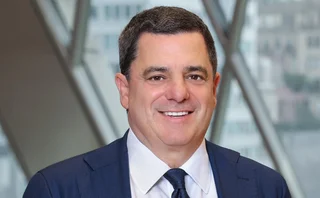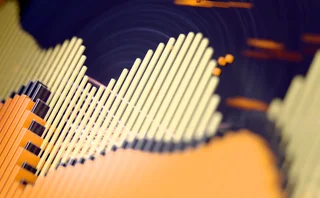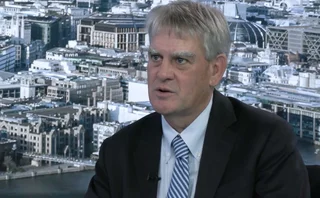
Deal of the year: Societe Generale
Asia Risk Awards 2022

With Chinese equities significantly down last year, a pension fund in South Korea was keen to get exposure to the market. But, being a pension fund, it had a limit to the risk that it could take on.
“We spent a long time discussing with the client how we could provide them with a safe product that would generate as much return as possible, whilst also minimising the risk that we were taking on our books,” said Olivier Renoux, Societe Generale Corporate and Investment Banking’s head of equity and quantitative investment strategies (QIS) structuring for Asia.
The eventual product that SG came out with was a 15-year range accrual note that referenced two underlyings: the spread between the 30-year and two-year yield on US swap rates (which is a very popular underlying for investors in the country) and a basket of futures based on China stocks traded in Hong Kong. The product was not capital-protected, and so SG also introduced a knock-in barrier that would protect the client up to a certain level.
SG also incorporated two other important features into the product.
One was a dynamic trading mechanism so that volatility within the structure would never go above 25%. This required a high level of structuring (the details of which SG are reluctant to publicly disclose), so that when volatility did spike, as it has done a few times during the Covid-19 pandemic, the vol target could still be managed.
The other was the inclusion of a 3.5% fixed dividend in the product, which allowed SG to offer the client an even higher coupon. The challenge here was in managing the implied dividend risk in the market. Again, this is where SG’s structuring expertise came in: by using a fixed-dividend mechanism, the bank was able to remove the uncertainty on dividend levels.
“We take pride in both of these mechanisms, because it would not be possible to add either of these features into the product without the structuring and trading expertise that we have, as well as the long-term relationships we have fostered with our clients,” says Renoux.
The trading expertise in particular allows the French bank to be more aggressive on price.
“If we can reduce our volatility risk, then, at the end of the day, we can offer more aggressive pricing for the client,” he tells Risk.net.
“The same is true in the fixed dividend space. It is important to be able to anticipate what the implied fixed dividends will be if we are going to be able to manage this risk correctly.”
By structuring the product in this way, SG was able to offer a highly attractive coupon of more than 9%.
The challenge of selling
The other challenging part of the product was to be able to sell it to the client itself.
“We are a derivatives house – we know how to structure and to manage this stuff. But, from the client’s perspective, it’s really not easy to understand how it works,” says Renoux.
“This is where the sales pitch came in. This required several months of working with the client, and helping them understand why the vol target will help them, and why it will help them get a higher return.”
“In structured products, high risk/high return is fairly normal. But with this product, we are able to offer decent returns in a far safer structure.”
SG has so far done two clips of this particular structure with the same client, one in March and the other in June. Both clips were for $15 million notional.
The bank is now looking at whether it can put on similar trades with other banks.
Having already structured this product for the Korean market should make it slightly easier to sell similar solutions to other clients, both inside and outside of Korea. However, as Renoux points out, every client is different – and this may slow down the speed at which the product can be replicated.
“We have to take a different approach for each client. Every situation is different. We have to have a very accurate understanding of what their portfolio looks like and what their risk appetite is,” he says.
“But this is where our sales team, and the relationship that we have with our clients, comes in.”
Renoux thinks that the product could be highly relevant in Japan and China, given the needs of pension funds in these two markets. SG is actively exploring the feasibility of developing a Nikkei version of the product at the moment.
“This isn’t going to be immediate. Rome wasn’t built in day, so it’s going to take time. But we are very committed to expanding in these markets,” he tells Risk.net.
Only users who have a paid subscription or are part of a corporate subscription are able to print or copy content.
To access these options, along with all other subscription benefits, please contact info@risk.net or view our subscription options here: http://subscriptions.risk.net/subscribe
You are currently unable to print this content. Please contact info@risk.net to find out more.
You are currently unable to copy this content. Please contact info@risk.net to find out more.
Copyright Infopro Digital Limited. All rights reserved.
As outlined in our terms and conditions, https://www.infopro-digital.com/terms-and-conditions/subscriptions/ (point 2.4), printing is limited to a single copy.
If you would like to purchase additional rights please email info@risk.net
Copyright Infopro Digital Limited. All rights reserved.
You may share this content using our article tools. As outlined in our terms and conditions, https://www.infopro-digital.com/terms-and-conditions/subscriptions/ (clause 2.4), an Authorised User may only make one copy of the materials for their own personal use. You must also comply with the restrictions in clause 2.5.
If you would like to purchase additional rights please email info@risk.net
More on Awards
Collateral management and optimisation product of the year: CloudMargin
Delivering the modern blueprint for enterprise collateral resilience
Flow market-maker of the year: Citadel Securities
Risk Awards 2026: No financing; no long-dated swaps? “No distractions,” says Esposito
Pricing and analytics: fixed income – Quantifi
Quantifi delivers high-performance, transparent and adaptable pricing and risk analytics for fixed income and credit markets
Derivatives house of the year: Citi
Risk Awards 2026: Rev up, RWAs down, as US bank gets back on track (with added XiNG and XiP)
Technology vendor of the year: SS&C Algorithmics
Risk Awards 2026: From cloud, to chips, to maths tricks – vendor getting more out of existing tech
SS&C Algorithmics: winner’s interview with Curt Burmeister
SS&C Algorithmics wins three categories in this year’s Markets Technology Awards in addition to Technology vendor of the year at the Risk Awards
Best vendor for system support and implementation: Murex
Murex wins Best vendor for system support and implementation at the Markets Technology Awards 2026
Pricing and analytics: cross-asset and structured – Murex
Murex wins Pricing and analytics: cross-asset and structured at the Markets Technology Awards 2026 thanks to its MX.3 platform







